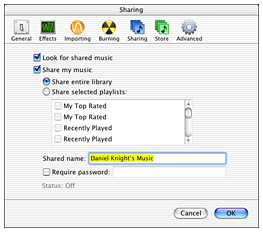|
|
|
iTunes Sharing Lets Mac Users Become Low-end Radio Stationsby Alan Zisman ( c) 2003 First published in LowEnd Mac , May 28, 2003 Mac2Windows column Mac2Windows is usually about making Macs and Windows
computers work together, but until Apple ports iTunes to Windows
(anticipated by the end of 2003), this column will only benefit Mac
users.
Recently, Apple made some big moves on the digital music front, gaining a lot of press for its iTunes Music Store. At the store, Apple has made over two hundred thousand tunes available for download at US$1 each with the blessing of the recording industry, yet with fewer restrictions than other commercial music-downloading services. Even though it's currently limited to US-located Mac-owners, Apple's Music Store was able to boast over two million tunes downloaded in its first weeks of operation. To make use of the iTunes Music Store, potential customers need to use iTunes version 4. While Apple stands to make a nice bundle of pocket change from the Music Store, there's another significant feature of the new iTunes that has gathered far less public comment. iTunes 4 has a sharing feature that offers every user
the potential to be (on a decidedly small-scale level) their own radio
station. Yes, iTunes now does music streaming. Go to the iTunes preferences, and you'll see a Sharing
icon. Click on it, and you'll see a simple-to-use set of options: If sharing is turned on, that dialogue will also show how many people are currently accessing your shared library. With sharing turned on (and iTunes running), your Mac magically becomes a music-streaming server, letting users on other Macs listen to the songs in your iTunes library. On Apple's iTunes
web page, the feature is mentioned, but the discussion about
it focuses on how it works with Rendezvous to automatically locate
other Macs on a home network. Their example states: "Let's say, for
instance, that you have thousands of AAC and MP3 music files stored on
a Mac in your home office. With iTunes 4, you can stream that music to
other Macintosh computers anywhere in your house." Apple neglects to mention that this sharing isn't limited to other Macs on your local network. In fact, with sharing turned on your Mac will happily stream music to any other iTunes user across the Internet. Major radio stations don't need to quake in their boots, however. There are a couple of pretty significant limitations built in. iTunes sharing is limited to a maximum of five users
at a time. This is probably a very good thing, as few of us have ISPs
who would be happy with the bandwidth consumed if large numbers of
people wanted to connect simultaneously. (To say nothing of the
demands this would place on your Mac's hardware). In order to connect
over the Internet, potential listeners will have to know your IP
address beforehand. In other words, you can listen to the tunes stored
in your home Mac's iTunes library while at work (assuming you also
have a Mac at work). And you can send your IP address to a few
friends, and they can listen to tunes stored in your iTunes library. You probably don't know your IP address offhand. And if you're connecting to the Internet via a router (perhaps connected to a cable or DSL broadband modem), your Mac's IP address over the LAN isn't its address over the Internet. You can find out the IP address your computer is using to connect to the Internet from What's My IP. And if there is a router in between your Mac and the Net, you will need to do a bit of configuration to allow requests made over the Internet to contact your Mac. On my wireless Linksys router, for instance, I had to log into the router's configuration program, go to the Advanced tab, then go to forwarding tab. There, I enabled Port 3689 for the Mac's network IP address. (If you have a dynamic IP address that changes frequently, you may want to sign on with a free service like dyndns.org that provides users with a virtual static address). This is not quite as transparent as Rendezvous automatically locating other Macs on your home network, but it's not too hard to do, either. Once that's done, your iTunes library is available online -- at least to anyone who knows your IP address and the password that you've set. There are a couple of ways to connect. You can click on the iTunes Advanced menu and choose its Connect to Shared Music item. Type in the IP address, and that library's share name should appear in the iTunes list of available sources. Alternatively, typing "daap:\\ip_address" in a browser should get you connected. Some Mac users have gone public with this, offering their libraries to the world. iTuneShare is maintaining lists of users, organized by music category. Unlike Napster, Limewire, Kazaa, and the like, iTunes
file sharing lets remote users listen to tunes across the Internet or
a local network, but it doesn't allow them to actually download the
music files onto their local computer. I'm sure this was done on
purpose, allowing Apple to argue that this iTunes feature isn't there
to encourage pirating of copyrighted music. A number of programs have been posted that get around this limitation, allowing users to actually copy music files from one Mac to another, but we're not going to tell you where to find them.
|
|
|
|
|
|
|
|
| Alan Zisman is a Vancouver educator, writer, and computer specialist. He can be reached at E-mail Alan |

 turn sharing on or off,
share all songs in your iTunes library (vs. specified playlists), and
whether or not to password-protect access to your iTunes library.
turn sharing on or off,
share all songs in your iTunes library (vs. specified playlists), and
whether or not to password-protect access to your iTunes library.